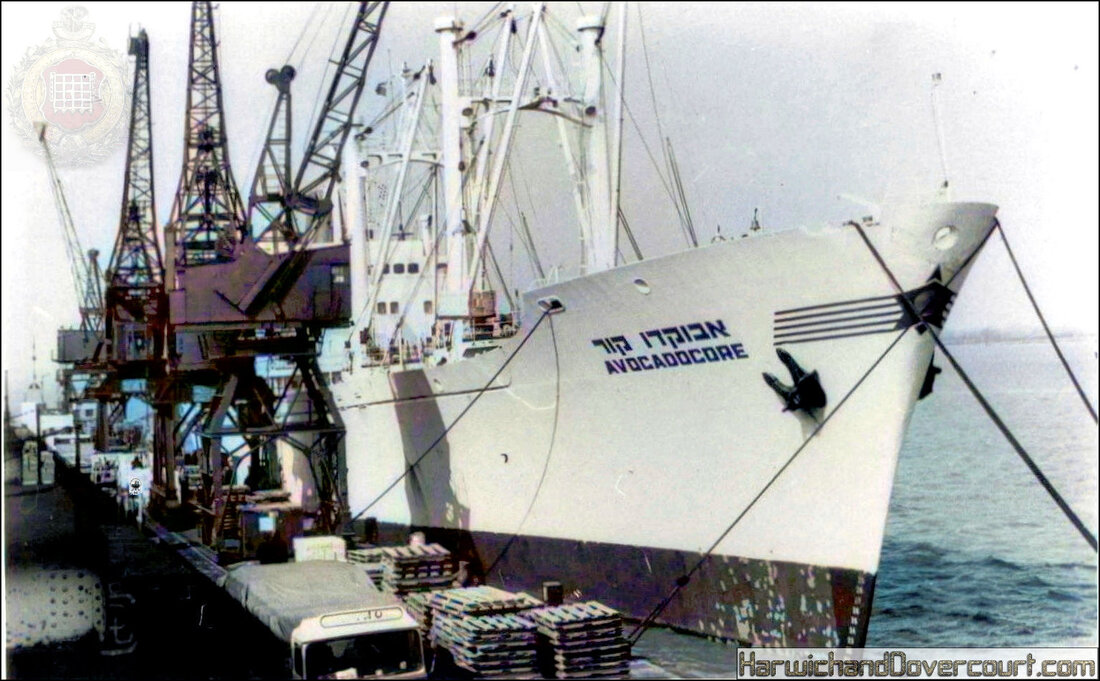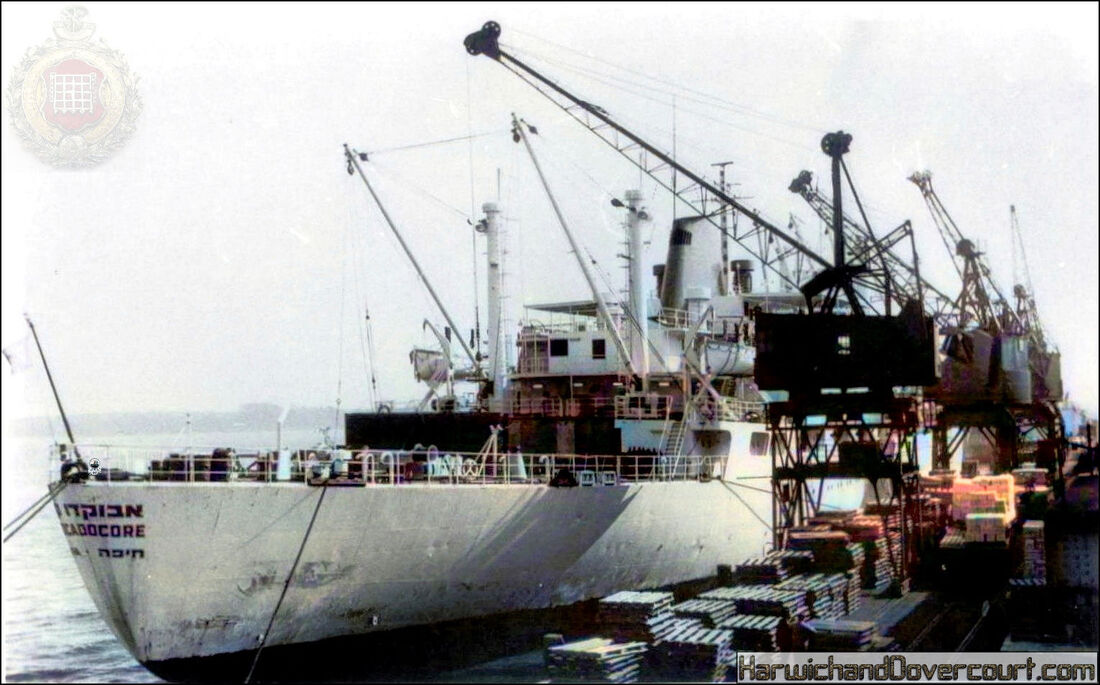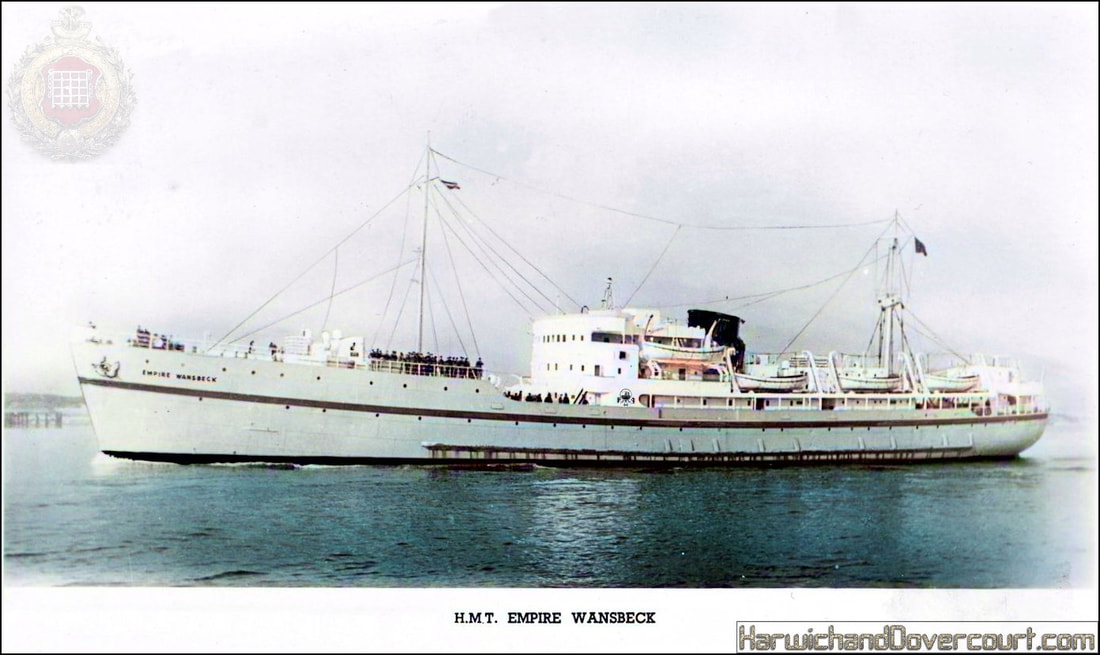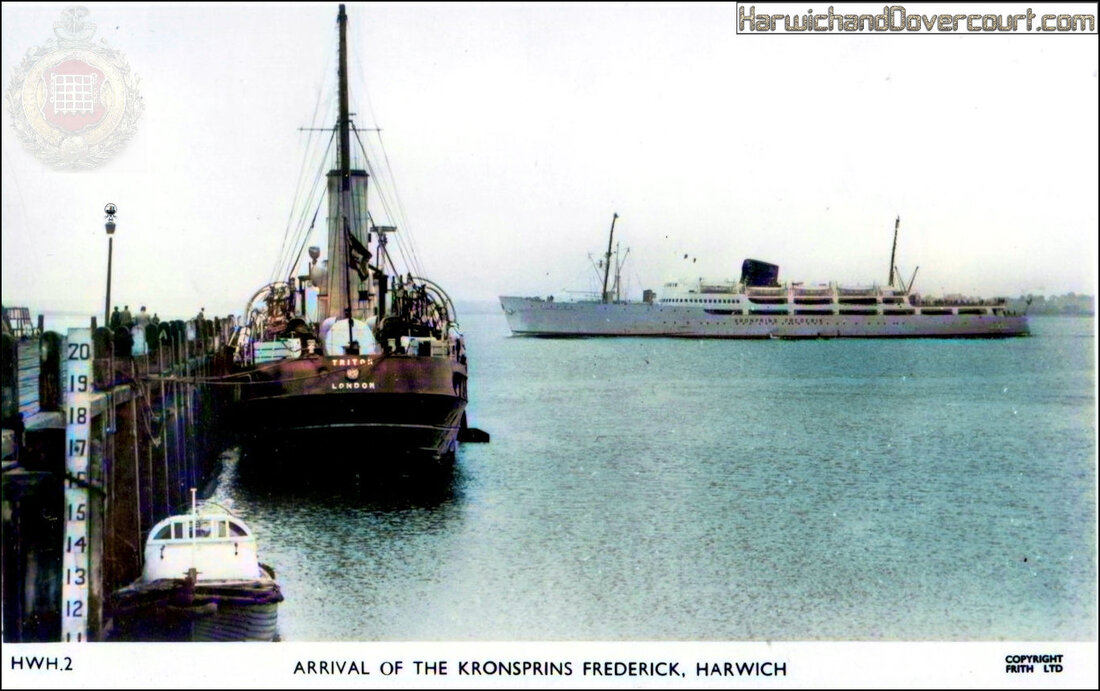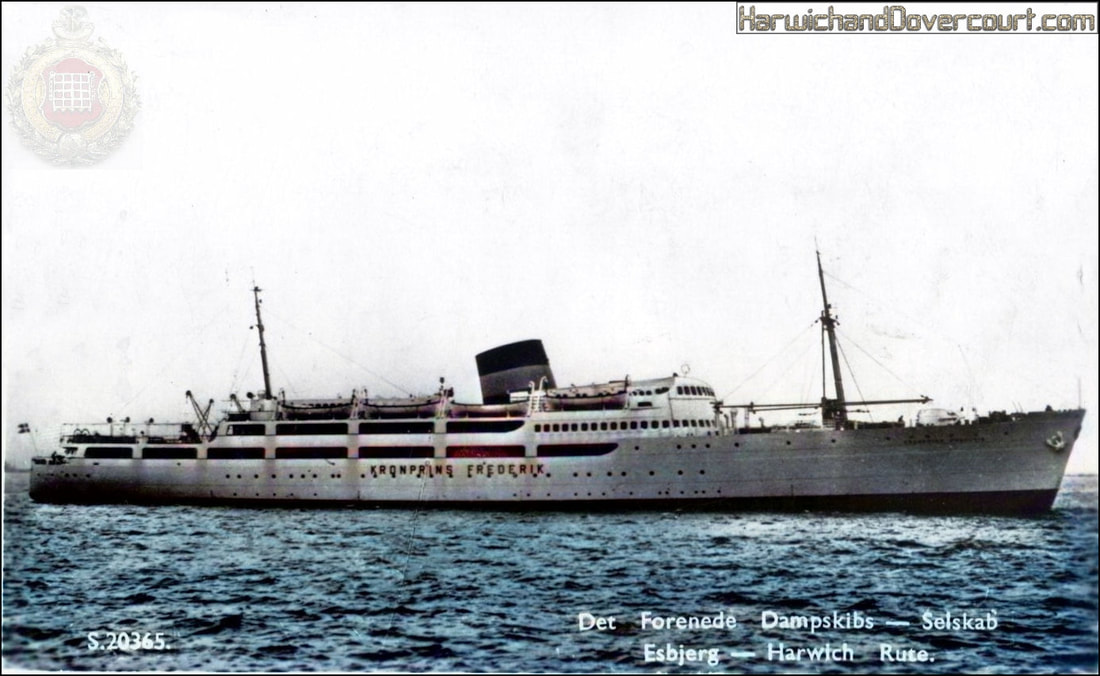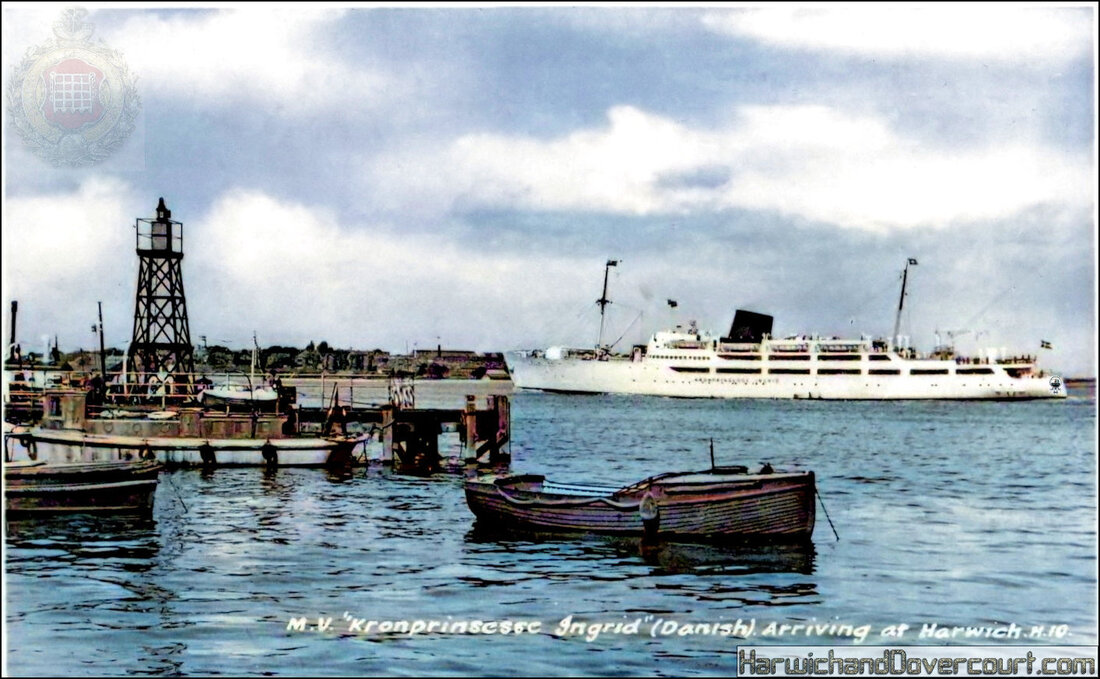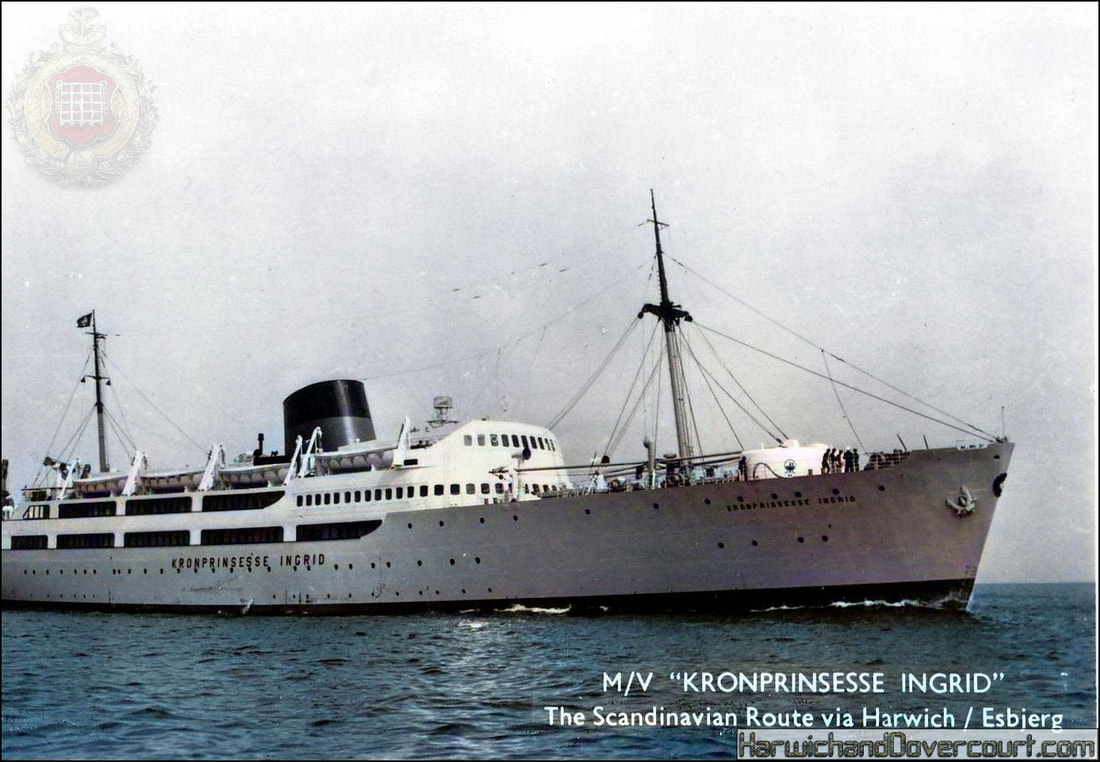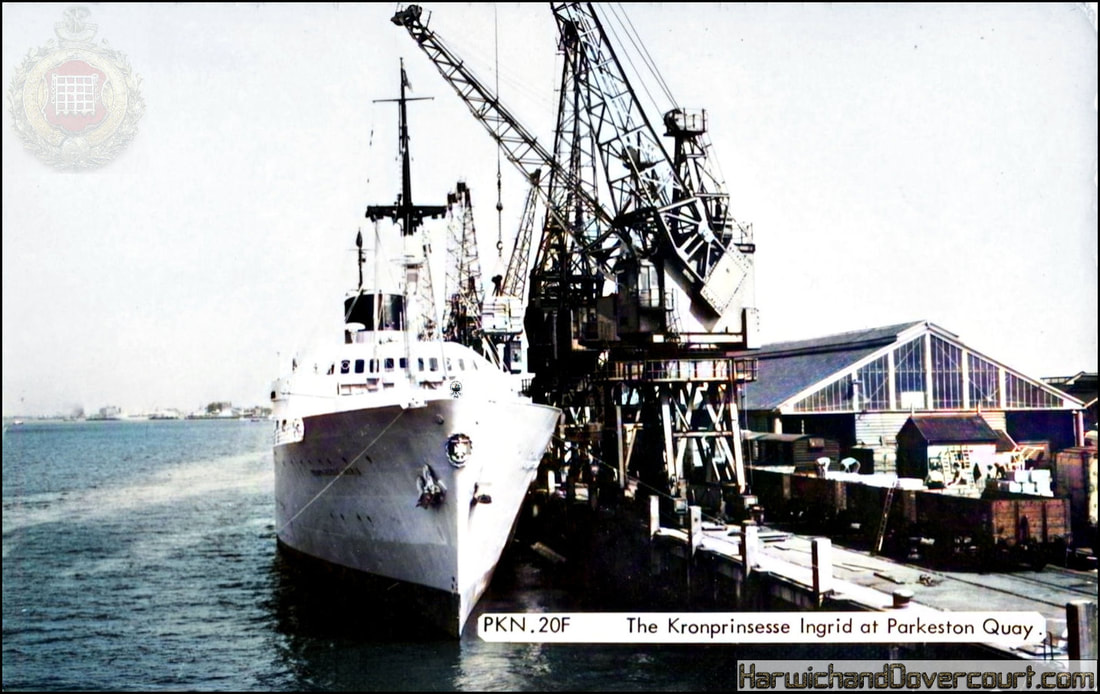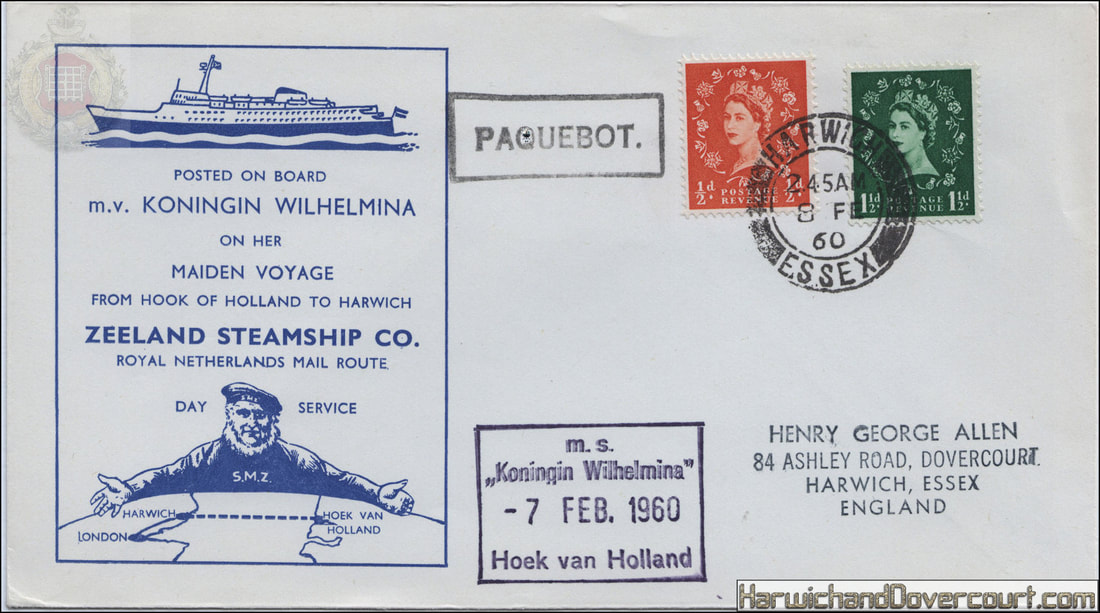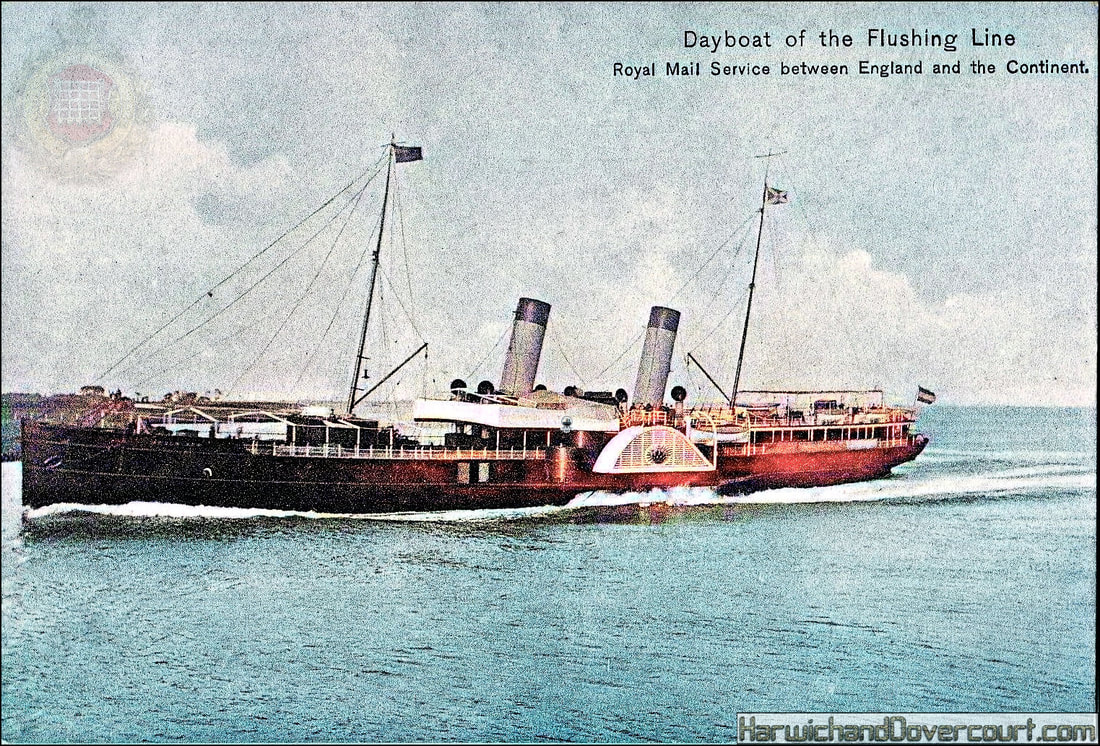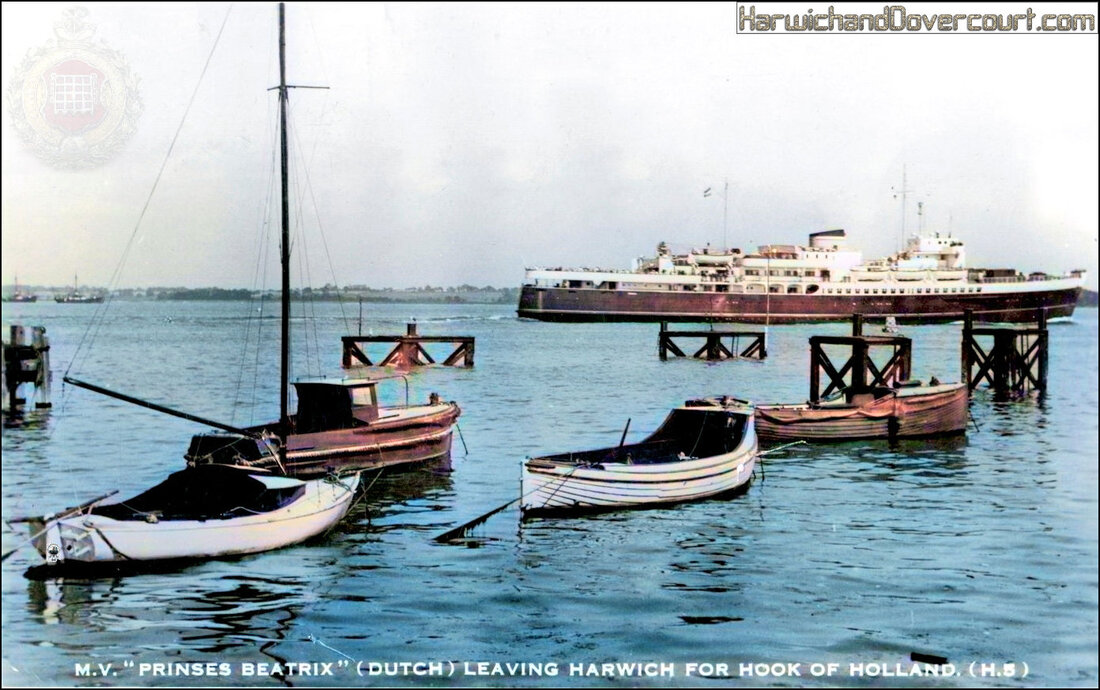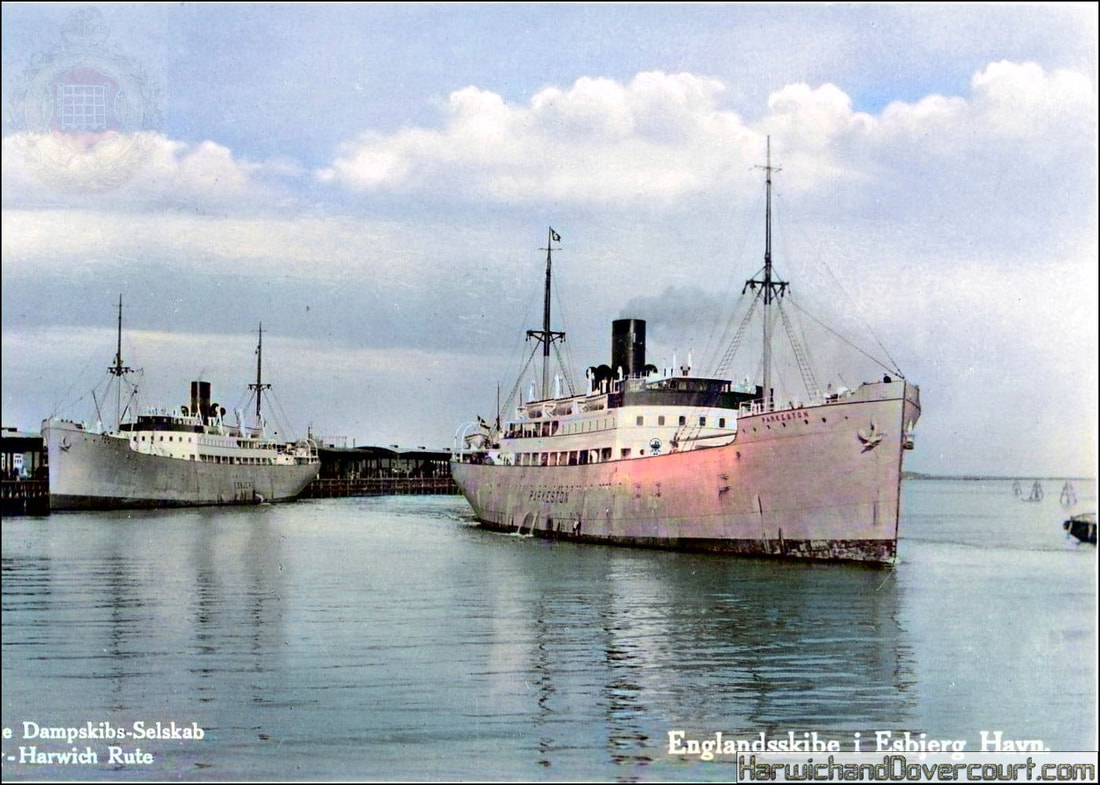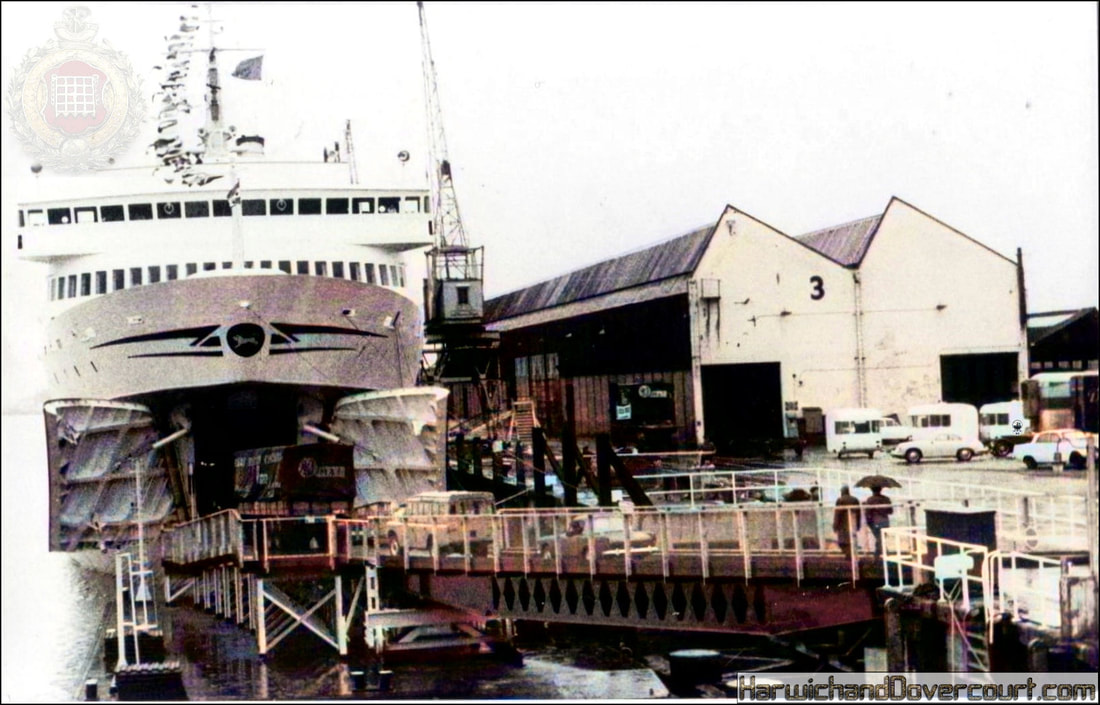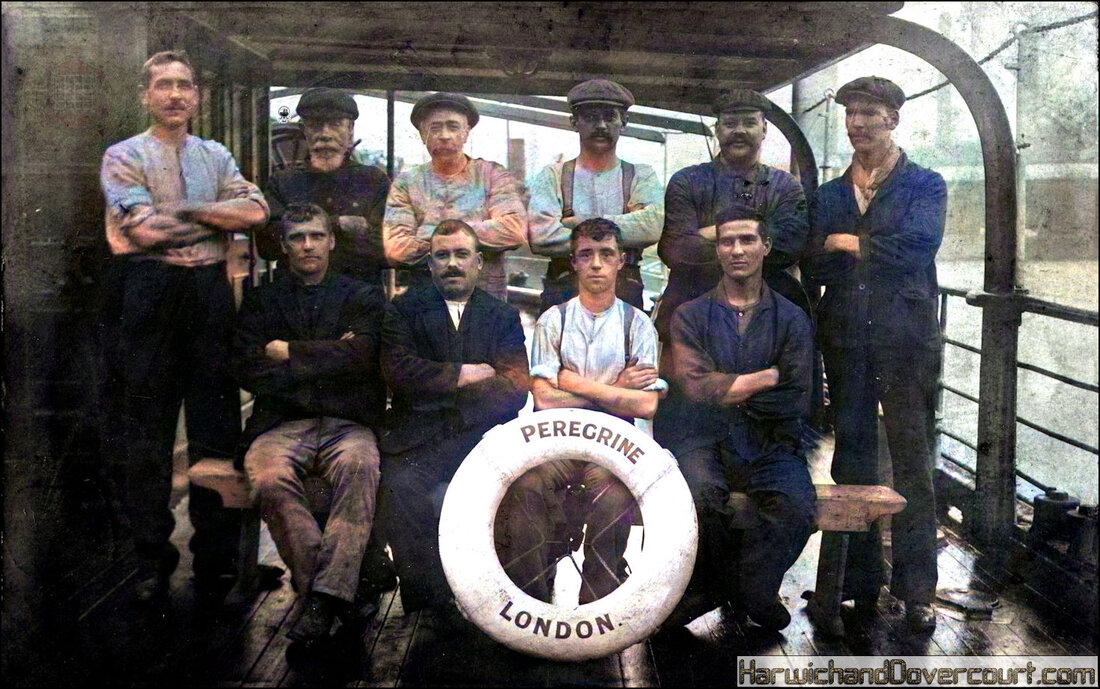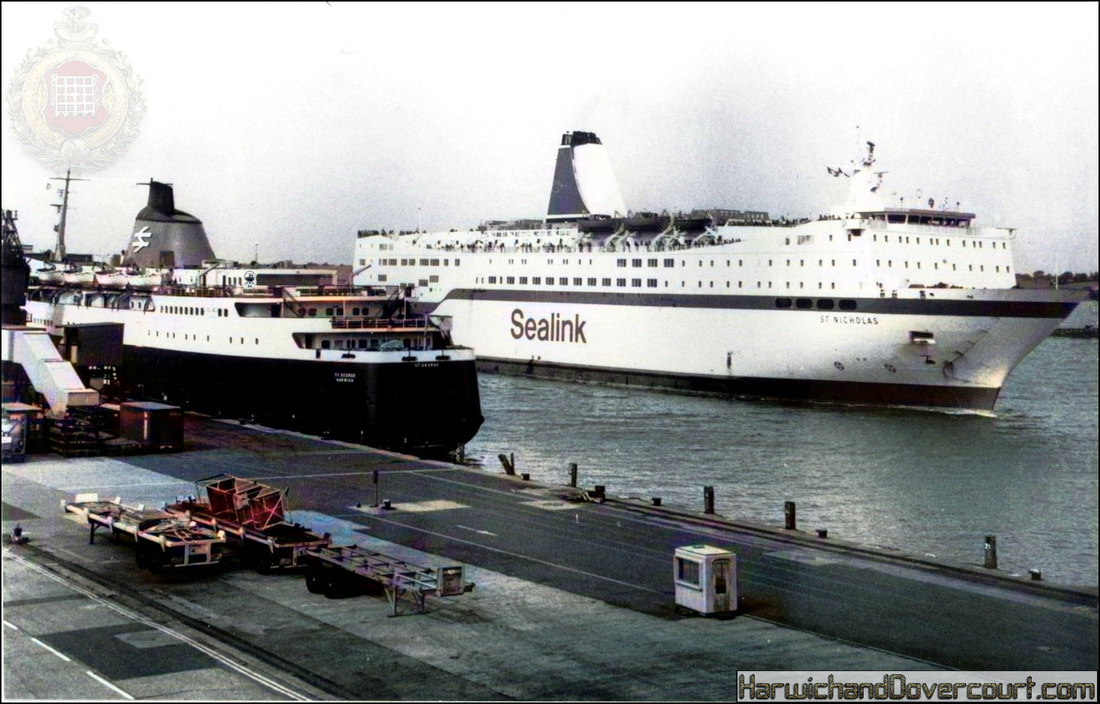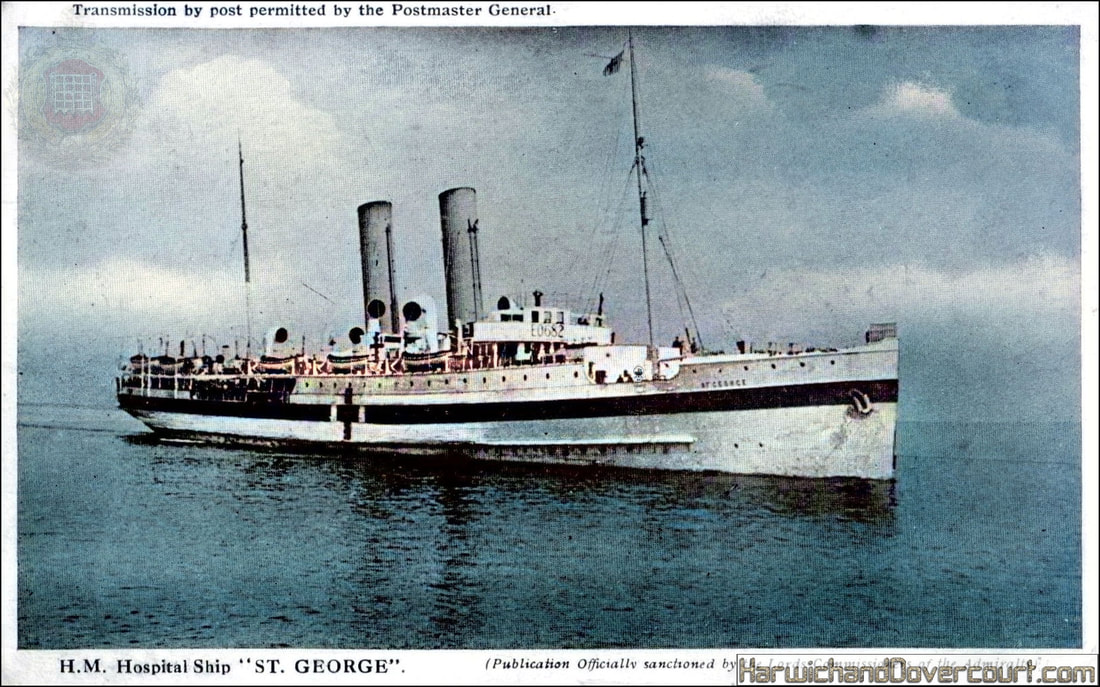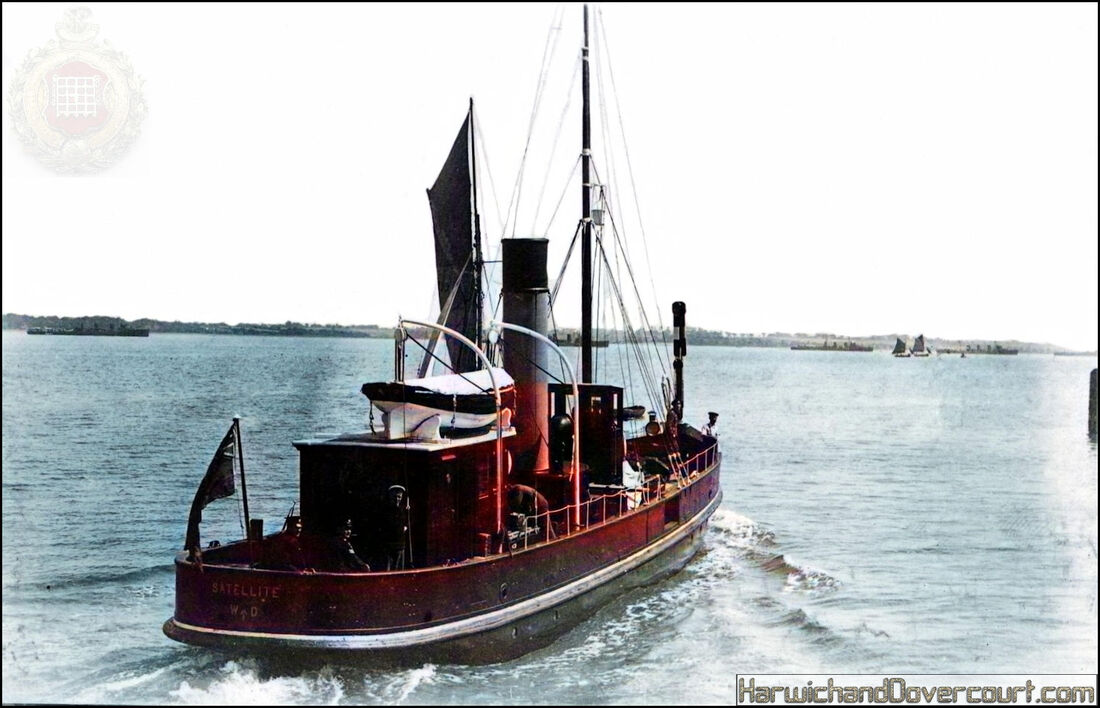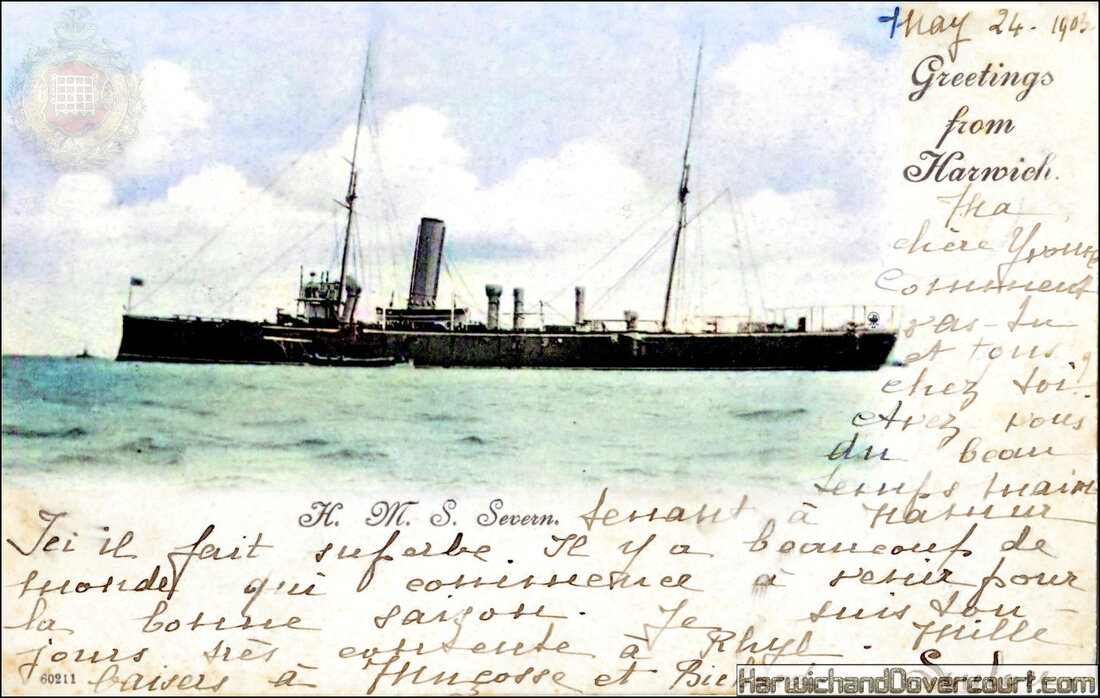Cargo & Crews
~ The Cargo Boat Avocadocore at Parkeston Quay, Essex (1974) H&D ~
The Avocadocore, 8,443 grt; 8,535 dwt.
Operator: Maritime Fruit Carrier Corp, Haifa, Israel. Flag: Israeli,
Built: 1965 by A/S Akers M/V, Oslo, Norway. Yard no 559. LR/IMO no: 6505416.
Main engine: seven-cylinder, two-stroke Akers-B&W 7-74VT2BF-160 of 11,500 bhp at 119 rpm. Speed: 20 knots.
1976-sold to Empresa Hondurena de Vapores SA, Puerto Cortes, Honduras (United Fruit Co, New York), renamed ORICA (Honduran flag).
1985-to breakers at Kaohsiung, Taiwan 15/1.
Photo: arriving Rotterdam 30/4/1969
Operator: Maritime Fruit Carrier Corp, Haifa, Israel. Flag: Israeli,
Built: 1965 by A/S Akers M/V, Oslo, Norway. Yard no 559. LR/IMO no: 6505416.
Main engine: seven-cylinder, two-stroke Akers-B&W 7-74VT2BF-160 of 11,500 bhp at 119 rpm. Speed: 20 knots.
1976-sold to Empresa Hondurena de Vapores SA, Puerto Cortes, Honduras (United Fruit Co, New York), renamed ORICA (Honduran flag).
1985-to breakers at Kaohsiung, Taiwan 15/1.
Photo: arriving Rotterdam 30/4/1969
~ The Cargo Boat Avogaddcore at Parkeston Quay, Essex II (1974) H&D ~
11 DFDS Seaways Dana Regina (1978) H&D FW
The Dana Regina was ordered in 1969 by DFDS, the oldest operational Danish shipping company. The ship was completed in 1974 and christened MS Dana Regina. After a promotional cruise from Copenhagen to Esbjerg via Harwich and London she started scheduled service on the Harwich–Esbjerg route on 8 July 1974. In January 1977 the ship was rebuilt at Hamburg, Germany with an enlarged car capacity. In October 1983 the Dana Regina was transferred to Copenhagen–Oslo route.
~ H.M.T. Empire Wansbeck (1959) H&D ~
A 3,374 ton diesel passenger vessel built by Danziger Werft A.G., Danzig and launched during November 1942 for North German Lloyd, Bremen but completion was deferred because of the war. In 1943 she was towed to Odense for completion by Odense Staalskibsvaerft A/S. As built she had accommodation for 1,020 passengers.
On 27 July 1943 she was sabotaged and her machinery made unserviceable. She arrived at Stettin for repair on the 16th August and redelivered to her owners on 26 January 1944 but then taken over by the German Navy for use as a mine-layer under the name Linz.
In 1945 she was seized by the Allies at Kielfjord and handed to the MOWT who renamed her Empire Wansbeck, as shown in this photograph, and arrived at Hull from Hamburg on 1 December 1945. She was placed under the management of Ellerman’s Wilson Line, Hull and refitted as a short-sea troopship. This photograph was obviously taken at this time as it shows her fore-deck crammed with many uniformed personnel. It appears that they might be all taking exercise around the decks.
In January 1946 her owners became the MOT while still managed by Wilson Line. During February 1946 she made her first crossing from Harwich to Hook of Holland on a route she was continuously employed until 26 September 1961, when she arrived at Parkeston Quay at the end of her last voyage and was then laid up.
In 1962 she was sold to Kavounides Shipping co. Ltd., Piraeus and renamed Esperos. In 1964 she was extensively rebuilt for passenger service between Rhodes and Venice and later for cruising.
On 14 March 1980 she left Piraeus under tow of Vernicos Dimitrios for demolition at Gandia, Spain.
On 27 July 1943 she was sabotaged and her machinery made unserviceable. She arrived at Stettin for repair on the 16th August and redelivered to her owners on 26 January 1944 but then taken over by the German Navy for use as a mine-layer under the name Linz.
In 1945 she was seized by the Allies at Kielfjord and handed to the MOWT who renamed her Empire Wansbeck, as shown in this photograph, and arrived at Hull from Hamburg on 1 December 1945. She was placed under the management of Ellerman’s Wilson Line, Hull and refitted as a short-sea troopship. This photograph was obviously taken at this time as it shows her fore-deck crammed with many uniformed personnel. It appears that they might be all taking exercise around the decks.
In January 1946 her owners became the MOT while still managed by Wilson Line. During February 1946 she made her first crossing from Harwich to Hook of Holland on a route she was continuously employed until 26 September 1961, when she arrived at Parkeston Quay at the end of her last voyage and was then laid up.
In 1962 she was sold to Kavounides Shipping co. Ltd., Piraeus and renamed Esperos. In 1964 she was extensively rebuilt for passenger service between Rhodes and Venice and later for cruising.
On 14 March 1980 she left Piraeus under tow of Vernicos Dimitrios for demolition at Gandia, Spain.
~ H.M.T. Empire Parkeston at Parkeston Quay Harwich (19--) H&D ~
Troopship H.M.T. Empire Parkeston at Parkeston Quay, she was on a regular run from Parkeston Quay, Harwich.
She was built in 1930 by Cammell Laird, Birkenhead, as the Prince Henry for Canadian National Steamships. 1946 she became Empire Parkeston. Scrapped in La Spezia, Italy in 1962.
She was built in 1930 by Cammell Laird, Birkenhead, as the Prince Henry for Canadian National Steamships. 1946 she became Empire Parkeston. Scrapped in La Spezia, Italy in 1962.
~ European Gateway on its side (1982) H&D ~
MS European Gateway was a roll-on roll-off (RORO) car and passenger ferry built in 1975, originally owned and operated by Townsend Thoresen.
On 19th December 1982, she capsized following a collision with Speedlink Vanguard off Harwich, settling on a sandbank. The ship had 34 passengers and 36 crew at the time.
Six people were killed in the capsizing. She was subsequently refloated and repaired, and served the Greek Islands as Penelope, until 2013 when she was scrapped at the Aliaga breakyards in Turkey.
On 19th December 1982, she capsized following a collision with Speedlink Vanguard off Harwich, settling on a sandbank. The ship had 34 passengers and 36 crew at the time.
Six people were killed in the capsizing. She was subsequently refloated and repaired, and served the Greek Islands as Penelope, until 2013 when she was scrapped at the Aliaga breakyards in Turkey.
~ Arrival of the Kronprins, Frederick Harwich (1959) Frith's H&D ~
Note mis-spelling on the card
Kronprins, Frederick
The ship was completed on 25 May 1941, towed to Copenhagen on 06th June 1941 and delivered to the owners on 19th June. Propulsion was provided by twin B&W 1050-VF-90 Diesel Engines (5,294 kW) and twin propellers which gave the ship a cruising speed of 20.5 knots.
On 19th April 1953, the ship arrived at Harwich after making passage from Esbjerg, Denmark and moored at Parkeston Quay. Soon after the passengers had disembarked a fire broke out in one of the passenger cabins. Fire fighting efforts by the ship’s crew were unable to control the fire. Local fire brigades arrived and provided additional assistance, however, the fire continued to rage out of control.
Kronprins Frederik was returned to service on the Esbjerg-Harwich route where the ship provided reliable service until 1963 when the ship was leased out for private charter to the Carlsberg Distribution Co Ltd, London, England for a passage departing from Harwich on 22nd May 1963 and sailing to Oslo, Norway, then on to Copenhagen, Denmark, returning to Harwich on 29th May. On 10th March 1976, the Kronprins Frederik was purchased by the Arab Navigation Company, Suez, Egypt, taking possession of the ship on 16th March and was renamed as the M/V Patra.
On 24th December 1976, the Patra departed Jeddah, Saudi Arabia on passage to Suez, Egypt with 353-387 passengers and 88-94 crew on board, The Patra, still in flames, sank a few hours later on the early morning of 25th December 1976 in over 450 meters of water. 102 lives were lost.
The ship was completed on 25 May 1941, towed to Copenhagen on 06th June 1941 and delivered to the owners on 19th June. Propulsion was provided by twin B&W 1050-VF-90 Diesel Engines (5,294 kW) and twin propellers which gave the ship a cruising speed of 20.5 knots.
On 19th April 1953, the ship arrived at Harwich after making passage from Esbjerg, Denmark and moored at Parkeston Quay. Soon after the passengers had disembarked a fire broke out in one of the passenger cabins. Fire fighting efforts by the ship’s crew were unable to control the fire. Local fire brigades arrived and provided additional assistance, however, the fire continued to rage out of control.
Kronprins Frederik was returned to service on the Esbjerg-Harwich route where the ship provided reliable service until 1963 when the ship was leased out for private charter to the Carlsberg Distribution Co Ltd, London, England for a passage departing from Harwich on 22nd May 1963 and sailing to Oslo, Norway, then on to Copenhagen, Denmark, returning to Harwich on 29th May. On 10th March 1976, the Kronprins Frederik was purchased by the Arab Navigation Company, Suez, Egypt, taking possession of the ship on 16th March and was renamed as the M/V Patra.
On 24th December 1976, the Patra departed Jeddah, Saudi Arabia on passage to Suez, Egypt with 353-387 passengers and 88-94 crew on board, The Patra, still in flames, sank a few hours later on the early morning of 25th December 1976 in over 450 meters of water. 102 lives were lost.
~ S.20365 Kronprins , Frederick Esjberg - Harwich Rute (1953) H&D ~
~ MV Kronprincesse Ingrid (Danish) arriving at Harwich FW
Built 1949 by Helsingör Vaerft, Helsingör / Denmark
Named KRONPRINSESSE INGRID for DFDS, Esbjerg / Denmark;
1969 renamed COPENHAGEN and shortly afterwards MIMIKA L.;
1978 renamed ALKYON;
1985 broken up
Named KRONPRINSESSE INGRID for DFDS, Esbjerg / Denmark;
1969 renamed COPENHAGEN and shortly afterwards MIMIKA L.;
1978 renamed ALKYON;
1985 broken up
~ Kronprinsesse Ingrid (1959) H&D ~
~ The Kronprinesse Ingrid at Parkeston Quay (1959) H&D ~
~ M.S. Koningin Welhelmina - Paquebot I (1960) Zeeland Ship Co H&D ~
Built for the Hook of Holland-Harwich day service of the Zeeland Steamship Company (SMZ), the motor ship Koningin Wilhelmina was delivered in January 1960 from the De Merwede shipyard in Hardinxveld. Fitted with a bow thrust unit and stabilisers, the ship was as modern as her futuristic appearance suggested - except for the fact that she was primarily a passenger, rather than a vehicle, ferry. Although the ship was actually built with a small side-loaded car garage with space for 45 vehicles, the Hook-Harwich route was still very much geared towards the large numbers of often train-connected foot passengers rather than motorists. At this time the original agreement, as reached between SMZ and the LNER in 1927 when the former had moved their services to Harwich from Folkestone, was still in force, with the Dutch ships covering the day services with the British operating overnight.
Joined on the route, operating the night service, by British Railway's Avalon of 1963, this pair were the final 'classic' passenger-only ships for the Hook of Holland service, and were relegated to secondary status with the 1968 delivery of the new purpose-built car ferries St George and Koningin Juliana. The Koningin Wilhelmina subsequently operated as a reserve ship as well as providing peak season support and extra sailings. This continued until 1978 when the new Prinses Beatrix was delivered and the 'Wilhelmina' was finally retired on 28 June.
Sale followed fairly speedily, with the Greek Ventouris family acquiring the ship, renaming her Captain Constantinos and deploying her on their Piraeus-Syros-Tinos-Mykonos operations. She was further renamed Panagia Tinoy in 1981, remaining with Ventouris Sea Lines although the name on the bow was later amended to Panagia Tinou. The ship spent a spell in the late 1980s operating under the AK Ventouris brand of one of the other branches of the Ventouris family, but she later returned to VSL. Finally replaced as a ferry in 1994, the ship was retained and transferred for operations as a day cruiser based in Crete under the name Artemis. With the collapse of Ventouris in late 1995, the ship was acquired by Minoan Cruises (a branch of Minoan Lines) and retained on her Cretan cruises. The end finally came in early 2001 and she fairly speedily arrived in India for breaking under the shortened name Temis.
~ M.S. Koningin Welhelmina - Paquebot II (1960) Zeeland Ship Co H&D ~
15 S.19909 Harwich - Flushing S.S. Mecklenburg (1938) H&D FW
This postcard shows the screw steamer 'Mecklenburg' arriving at Harwich from Vlissingen (Flushing).
Two of the 1909 turbines, Prinses Juliana and Mecklenberg, were lost within days of each other early in 1916, and replacements were built in 1920 and 1922, becoming the Prinses Juliana and Mecklenberg. These were built in Holland using the original Fairfield drawings. Prinses Juliana (2) joined Oranje Nassau on the Vlissingen (Flushing)-Folkestone night service. Mecklenberg (2) inaugurated a new Vlissingen (Flushing)-Folkestone day service.
In January 1927, both ships transferred to Harwich. Their boat decks were extended and the promenade decks were glazed. Prinses Juliana (2) was lost in World War 2, when she was bombed in May 1940 whilst taking troops from Vlissingen to Ijmuiden. Mecklenberg (2) escaped to the UK and was used as an accommodation ship and assault landing ship for the Normandy invasion.
She survived the Second War, and re-entered day services from Harwich to Holland in 1947. When the 1939 diesels returned to service in 1948, Mecklenberg (2) introduced a new twice-weekly summer day service between Vlissingen (Flushing) and Folkestone in July 1949. This service survived until September 1952, since when all subsequent services have run between Harwich and the Hook of Holland. She was maintained as reserve ship until sold for scrap in 1960 on the arrival of the Koningin Wilhelmina (2).
Two of the 1909 turbines, Prinses Juliana and Mecklenberg, were lost within days of each other early in 1916, and replacements were built in 1920 and 1922, becoming the Prinses Juliana and Mecklenberg. These were built in Holland using the original Fairfield drawings. Prinses Juliana (2) joined Oranje Nassau on the Vlissingen (Flushing)-Folkestone night service. Mecklenberg (2) inaugurated a new Vlissingen (Flushing)-Folkestone day service.
In January 1927, both ships transferred to Harwich. Their boat decks were extended and the promenade decks were glazed. Prinses Juliana (2) was lost in World War 2, when she was bombed in May 1940 whilst taking troops from Vlissingen to Ijmuiden. Mecklenberg (2) escaped to the UK and was used as an accommodation ship and assault landing ship for the Normandy invasion.
She survived the Second War, and re-entered day services from Harwich to Holland in 1947. When the 1939 diesels returned to service in 1948, Mecklenberg (2) introduced a new twice-weekly summer day service between Vlissingen (Flushing) and Folkestone in July 1949. This service survived until September 1952, since when all subsequent services have run between Harwich and the Hook of Holland. She was maintained as reserve ship until sold for scrap in 1960 on the arrival of the Koningin Wilhelmina (2).
Day boat of the Flushing Line, Royal Mail Service between England and the Continent (1908)
Paddle steamers were modified as day boats for transportation during this era to and the Nederland, of Zeeland SS Co. The Fleet, was contracted by British Royal Mail to carry mail and passengers between Queensborough, England and Vlissienge (Flushing) Netherlands from 1886-1910.
The Nederland was built by Fairfields, and had two broad black turbines. It was used as a day service ship between England and the Netherlands. The ship was replaced by new turbines in 1910, dating the particular ship between 1886-1910.
The Nederland was built by Fairfields, and had two broad black turbines. It was used as a day service ship between England and the Netherlands. The ship was replaced by new turbines in 1910, dating the particular ship between 1886-1910.
~ Moonlight at Harwich Essex (1912) C.W. Faulkner & Co H&D ~
~ S.20268. Zeeland Steamship Co. M.V. Prinses Beatrix. (1948) Bridge House H&D ~
HMS Princess Beatrix was a commando troop ship of the Royal Navy during the Second World War.
Built as a civilian passenger liner in 1939, she was named the MS Prinses Beatrix, after Princess Beatrix of the Netherlands, and operated by Stoomvaart Maatschappij Zeeland (SMZ) (The Zealand Steamship Company) between Flushing and Harwich, along with her sister ship, MS Koningin Emma. After fleeing to Britain after the German invasion in 1940, she was requisitioned by the British Ministry of War Transport, renamed HMS Princess Beatrix and converted to a troopship at Harland and Wolff's yard in Belfast. During the war her main role was transporting British Commandos, and she participated in the Lofoten Islands Raid and the Dieppe Raid. She had the advantage of a high speed that allowed hit and run operations. Later designated as a landing ship, infantry (medium) she took part in the landings in North Africa, Sicily, Salerno, Anzio, and southern France. In 1946 Princess Beatrix was returned to her owners and continued to operate as ferry from Hook of Holland until 1969, when she was scrapped in Antwerp, Belgium.
Return to the Netherlands
Decommissioned after the war, she was disarmed at Greenock, and on 13 April 1946 arrived at her home port of Vlissingen to be returned to the Dutch government. She served as a military transport for a time before being handed back to SMZ, and resumed her original name MS Prinses Beatrix.
Post-war shortages of materials and labour meant that it was 31 May 1948 before Prinses Beatrix could return to service, sailing for the first time to Harwich from the Hook of Holland. She remained in service on the same route until 1968, when she was replaced by a new generation of roll-on/roll-off ships. The thirty-year-old Prinses Beatrix was taken out of service and sold for scrap just before the year's end in Antwerp.
Built as a civilian passenger liner in 1939, she was named the MS Prinses Beatrix, after Princess Beatrix of the Netherlands, and operated by Stoomvaart Maatschappij Zeeland (SMZ) (The Zealand Steamship Company) between Flushing and Harwich, along with her sister ship, MS Koningin Emma. After fleeing to Britain after the German invasion in 1940, she was requisitioned by the British Ministry of War Transport, renamed HMS Princess Beatrix and converted to a troopship at Harland and Wolff's yard in Belfast. During the war her main role was transporting British Commandos, and she participated in the Lofoten Islands Raid and the Dieppe Raid. She had the advantage of a high speed that allowed hit and run operations. Later designated as a landing ship, infantry (medium) she took part in the landings in North Africa, Sicily, Salerno, Anzio, and southern France. In 1946 Princess Beatrix was returned to her owners and continued to operate as ferry from Hook of Holland until 1969, when she was scrapped in Antwerp, Belgium.
Return to the Netherlands
Decommissioned after the war, she was disarmed at Greenock, and on 13 April 1946 arrived at her home port of Vlissingen to be returned to the Dutch government. She served as a military transport for a time before being handed back to SMZ, and resumed her original name MS Prinses Beatrix.
Post-war shortages of materials and labour meant that it was 31 May 1948 before Prinses Beatrix could return to service, sailing for the first time to Harwich from the Hook of Holland. She remained in service on the same route until 1968, when she was replaced by a new generation of roll-on/roll-off ships. The thirty-year-old Prinses Beatrix was taken out of service and sold for scrap just before the year's end in Antwerp.
~ ( H.5 ) M.V Prinses Beatrix (Dutch) Leaving Harwich For The Hook of Holland (1960) M&L ~
~ S.16104. M.S. Parkeston Royal Danish Mail Route (1950) H&D ~
M.S. Parkeston, built in 1925 and disposed of in 1964. Operated by DFDS on the Harwich-Esbjerg service.
M.S.Parkeston was the first of four sisters (Jylland, Esbjerg and England) for the Esbjerg-Harwich service.
M.S.Parkeston was the first of four sisters (Jylland, Esbjerg and England) for the Esbjerg-Harwich service.
~ M.S. Parkeston & Sister Ship Esbjerg (1962) H&D ~
~ The Prinz Hamlet Departing Harwich (1973) H&D ~
Prinz Hamlet was built in 1973 at Rendsburg for Prinz Ferries and used on their Harwich-Hamburg service. From 1981 this service passed to DFDS, who chartered the Prinz Hamlet followed by purchase in May 1987 when she was renamed Prins Hamlet. She ran on various DFDS services, mainly from Newcastle, until sale to Stena Line in September 1988. Stena briefly renamed her Stena Baltica before a charter to Polferries (Polska Zegluga Baltyska) as Nieborow. In 2002 she passed to Montenegro Lines for services to Italy as Sveti Stefan II.
~ M-V Prins Hamlet Arriving at No 3 Berth (1973) H&D ~
~ S.S. Peregrine loading at Parkeston Quay (1912) H&D ~
The S.S. Peregrine of London ; a steamer of about 780 tons registered to the General Steam Navigation Company
The S.S. 'Peregrine' represents the type of steam ships used for short-sea shipping in Europe. The 'Peregrine' was initially built for the General Steam Navigation Company in London, to transport cargo between British and north-western European ports before it was floundered on her way from Rotterdam. to London with a general cargo, and having on board 59 passengers, as well as a crew of 33 hands.
In this case of the Walton rescue, the Life-boat James Stevens No. 14 was called out at 10.30 P.M. on the 29th December 1918 a telephone message having reported that the s.s. Peregrine was ashore on the Longsand with about 60 passengers on board, and that she required immediate assistance. The weather was thick with sleet and rain, and an E. by N. gale was blowing when the crew of the Life-boat assembled.
A tempestuous sea was running, which broke incessantly over the boat, and by the time 'the James Stevens had reached the Inner Sands every member of the crew, in spite of his oilskins, was soaked to the skin.
From the original message the Coxswain, William Hammond, had learnt that the vessel was on the N.E. part of the Longsand, but it required very long and careful search to locate the vessel.
At one time a flare was seen and the boat proceeded in its direction, but nothing could be found. She then worked carefully down along the Sand, and at last discovered the wreck. Heavy seas were breaking over the vessel, and six attempts were made before the Lifeboat succeeded in getting alongside. It was found that she was the Peregrine, of London.
The vessel lay on the Sands at the mercy of wind and seas. All the boats had been washed away with the exception of one, and this one they were unable to launch.
When the Life-boat arrived it was seen that the vessel was in a hopeless condition, and as soon as the Captain informed the Coxswain that there were passengers on board the latter suggested that they should at once be removed by the Life-boat and transferred to a Patrol vessel which had come to their assistance, but which was, of course, unable to approach the wreck. The whole of the passengers, 59 in number, mostly women and children, together with the Chief Steward, were taken into the Life-boat— a most difficult operation in the heavy seas and the intense darkness. The work was, however, successfully accomplished without mishap, and as soon as possible the shipwrecked passengers were transferred to the Patrol-boat.
Thereupon the James Stevens immediately returned to the steamer, which had, meanwhile, become a total wreck, having broken her back and parted amidships. The boat could not get near until the tide flowed, but as soon as there was sufficient water the boat, after considerable difficulty, succeeded in taking off all those who still remained on board. While carrying out this difficult task the Life-boat was stove in and otherwise damaged. The work of rescue occupied the Life - boatmen throughout the night, and the boat started for home at about 9 o'clock-on Sunday morning, the 30th December.
According to a newspaper account, information that the boat was returning " had caused a large crowd of people to assemble in order to cheer the incoming men. Immediately on their landing three of the heartiest cheers were vociferously given by the rescued crew for their gallant rescuers." Dry clothing was promptly supplied, and accommodation found for all the shipwrecked I men. Among the passengers on the Peregrine were Belgians, French and Italians.
In recognition of the gallantry and great skill displayed in extremely bad weather, the Committee granted the | Silver Medal of the Institution to j William Hammond, and the Bronze Medal of the Institution to the Second | Coxswain, John C. Byford. They also I granted these men and each of the other i members of the crew an additional ' monetary reward.
It is very gratifying to be able to report that at the time of the rescue Captain W. N. Braithwaite, the Master of the steamer, expressed his and his cr'ew's gratitude for the splendid services rendered to them and for the gallantry shown.
The S.S. 'Peregrine' represents the type of steam ships used for short-sea shipping in Europe. The 'Peregrine' was initially built for the General Steam Navigation Company in London, to transport cargo between British and north-western European ports before it was floundered on her way from Rotterdam. to London with a general cargo, and having on board 59 passengers, as well as a crew of 33 hands.
In this case of the Walton rescue, the Life-boat James Stevens No. 14 was called out at 10.30 P.M. on the 29th December 1918 a telephone message having reported that the s.s. Peregrine was ashore on the Longsand with about 60 passengers on board, and that she required immediate assistance. The weather was thick with sleet and rain, and an E. by N. gale was blowing when the crew of the Life-boat assembled.
A tempestuous sea was running, which broke incessantly over the boat, and by the time 'the James Stevens had reached the Inner Sands every member of the crew, in spite of his oilskins, was soaked to the skin.
From the original message the Coxswain, William Hammond, had learnt that the vessel was on the N.E. part of the Longsand, but it required very long and careful search to locate the vessel.
At one time a flare was seen and the boat proceeded in its direction, but nothing could be found. She then worked carefully down along the Sand, and at last discovered the wreck. Heavy seas were breaking over the vessel, and six attempts were made before the Lifeboat succeeded in getting alongside. It was found that she was the Peregrine, of London.
The vessel lay on the Sands at the mercy of wind and seas. All the boats had been washed away with the exception of one, and this one they were unable to launch.
When the Life-boat arrived it was seen that the vessel was in a hopeless condition, and as soon as the Captain informed the Coxswain that there were passengers on board the latter suggested that they should at once be removed by the Life-boat and transferred to a Patrol vessel which had come to their assistance, but which was, of course, unable to approach the wreck. The whole of the passengers, 59 in number, mostly women and children, together with the Chief Steward, were taken into the Life-boat— a most difficult operation in the heavy seas and the intense darkness. The work was, however, successfully accomplished without mishap, and as soon as possible the shipwrecked passengers were transferred to the Patrol-boat.
Thereupon the James Stevens immediately returned to the steamer, which had, meanwhile, become a total wreck, having broken her back and parted amidships. The boat could not get near until the tide flowed, but as soon as there was sufficient water the boat, after considerable difficulty, succeeded in taking off all those who still remained on board. While carrying out this difficult task the Life-boat was stove in and otherwise damaged. The work of rescue occupied the Life - boatmen throughout the night, and the boat started for home at about 9 o'clock-on Sunday morning, the 30th December.
According to a newspaper account, information that the boat was returning " had caused a large crowd of people to assemble in order to cheer the incoming men. Immediately on their landing three of the heartiest cheers were vociferously given by the rescued crew for their gallant rescuers." Dry clothing was promptly supplied, and accommodation found for all the shipwrecked I men. Among the passengers on the Peregrine were Belgians, French and Italians.
In recognition of the gallantry and great skill displayed in extremely bad weather, the Committee granted the | Silver Medal of the Institution to j William Hammond, and the Bronze Medal of the Institution to the Second | Coxswain, John C. Byford. They also I granted these men and each of the other i members of the crew an additional ' monetary reward.
It is very gratifying to be able to report that at the time of the rescue Captain W. N. Braithwaite, the Master of the steamer, expressed his and his cr'ew's gratitude for the splendid services rendered to them and for the gallantry shown.
~ Fireman on the S.S. Peregrine, London (19120) at Harwich H&D ~
~ The Screw Steamer The "Quenast" at Harwich (1906) H&D ~
1895 built Beverley - 'Quenast' Steel Screw Steamer, registered Hull, 40 tons, 74 x 15 x 8ft, 14 h.p. Official No. 105054. 1896 for David Cook, 4 Delapole Place, Drypool, Hull. 5th April 1899 Mr. D. A. Blow well known as the owner of the steamer running from Hull to River Head, Grimsby died at Buxton. 1900 owned by David A. Blow, Grimsby. 1910/47 for Nelson Blow, River Head, Grimsby.
Whilst on voyage from Tees to Antwerp with salt in 1939, she sank 3 miles north from the Noord Hinder LV
Whilst on voyage from Tees to Antwerp with salt in 1939, she sank 3 miles north from the Noord Hinder LV
~ British Rail "St George" and Sealink "St Nicholas" at Parkeston Quay (1983) H&D ~
The MS Normandy was a ferry, last owned by the Singapore-based oil service company Equinox Offshore Accommodation, under charter to the Morocco-based ferry operator Ferrimaroc. She was built in 1981 by Götaverken, Gothenburg, Sweden, and first entered service in 1982 as MS Prinsessan Birgitta for Stena Sessan Line. She also served under the names MS St Nicholas and MS Stena Normandy.
Concept and construction
The ship latterly known as MS Normandy was originally ordered from Götaverken in the late 1970s by Sessan Linjen, Sweden, with a planned delivery date in late 1981. Before the ship was completed, Sessan Linjen's main rival Stena Line purchased the majority of shares in Sessan, leading to the formation of Stena Sessan Line. After Stena acquired Sessan they cancelled the order for the new ship, and the shipyard were forced to complete her on their own account. Temporarily named MS GV 909 and registered in Gothenburg, the ship was completed in December 1981 and subsequently laid up in Gothenburg.
Service history
1982-1983: Stena Line
In May 1982, Stena Sessan changed their mind and decided to purchase the GV 909 after all. The company wanted to name the ship Drottning Silvia in honour of Queen Silvia of Sweden, but the Royal Household of Sweden declined. Eventually the ship was named M/S Prinsessan Birgitta in honour Princess Birgitta, sister of King Carl XVI Gustav. Princess Brigitta herself christened the ship on 7 June 1982 (the ship had already entered traffic on 3 June). Prinsessan Birgitta's service with Stena Sessan proved to be short, as she was chartered to Sealink in February 1983.
1983-1996: Sealink
Prior to entering service with Sealink, Prinsessan Birgitta was rebuilt at Götaverken with additional cabin facilities, renamed MS St Nicholas and registered under the flag of the United Kingdom, with London as her home port. In June 1983, she was set on Sealink's Hook of Holland—Harwich route. During the same month she was sold by Stena to Hill Samuel Trading Ltd, who continued chartering her to Sealink. In 1986 the ship was sold again, this time to a group of Stena subsidiaries. During the following two years she was sold three more times from one Stena subsidiary to another. None of these sales had any effect on her traffic, but in 1988 her home port was changed to Nassau, Bahamas.
In 1989, St Nicholas was sold again, this time to the Sweden-based Rederi AB Gotland, who continued to charter the ship to Sealink. In 1990 Stena Line took over the Sealink services and their former ship. In January 1991 St Nicholas was rebuilt at Lloyd Werft, Bremerhaven, Germany and renamed MS Stena Normandy. After briefly returning to the Hook of Holland—Harwich route, she was transferred to the Southampton—Cherbourg service in June 1991. She stayed on the service until November 1996 (her last passenger sailing for Stena being from Cherbourg to Southampton on 1 December), when her charter agreement to Stena expired and she was laid up in Dunkerque.
Concept and construction
The ship latterly known as MS Normandy was originally ordered from Götaverken in the late 1970s by Sessan Linjen, Sweden, with a planned delivery date in late 1981. Before the ship was completed, Sessan Linjen's main rival Stena Line purchased the majority of shares in Sessan, leading to the formation of Stena Sessan Line. After Stena acquired Sessan they cancelled the order for the new ship, and the shipyard were forced to complete her on their own account. Temporarily named MS GV 909 and registered in Gothenburg, the ship was completed in December 1981 and subsequently laid up in Gothenburg.
Service history
1982-1983: Stena Line
In May 1982, Stena Sessan changed their mind and decided to purchase the GV 909 after all. The company wanted to name the ship Drottning Silvia in honour of Queen Silvia of Sweden, but the Royal Household of Sweden declined. Eventually the ship was named M/S Prinsessan Birgitta in honour Princess Birgitta, sister of King Carl XVI Gustav. Princess Brigitta herself christened the ship on 7 June 1982 (the ship had already entered traffic on 3 June). Prinsessan Birgitta's service with Stena Sessan proved to be short, as she was chartered to Sealink in February 1983.
1983-1996: Sealink
Prior to entering service with Sealink, Prinsessan Birgitta was rebuilt at Götaverken with additional cabin facilities, renamed MS St Nicholas and registered under the flag of the United Kingdom, with London as her home port. In June 1983, she was set on Sealink's Hook of Holland—Harwich route. During the same month she was sold by Stena to Hill Samuel Trading Ltd, who continued chartering her to Sealink. In 1986 the ship was sold again, this time to a group of Stena subsidiaries. During the following two years she was sold three more times from one Stena subsidiary to another. None of these sales had any effect on her traffic, but in 1988 her home port was changed to Nassau, Bahamas.
In 1989, St Nicholas was sold again, this time to the Sweden-based Rederi AB Gotland, who continued to charter the ship to Sealink. In 1990 Stena Line took over the Sealink services and their former ship. In January 1991 St Nicholas was rebuilt at Lloyd Werft, Bremerhaven, Germany and renamed MS Stena Normandy. After briefly returning to the Hook of Holland—Harwich route, she was transferred to the Southampton—Cherbourg service in June 1991. She stayed on the service until November 1996 (her last passenger sailing for Stena being from Cherbourg to Southampton on 1 December), when her charter agreement to Stena expired and she was laid up in Dunkerque.
~ St George H.M. Hospital Ship (1917) H&D ~
HMHS St George
The Great Western Railway’s ships operated in connection with the company's trains to provide services to Ireland, the Channel Islands and France. Powers were granted by Act of Parliament for the Great Western Railway (GWR) to operate ships in 1871. The following year the company took over the ships operated by Ford and Jackson on the route between Wales and Ireland. Services were operated between Weymouth, the Channel Islands and France on the former Weymouth and Channel Islands Steam Packet Company routes. Smaller GWR vessels were also used as tenders at Plymouth and on ferry routes on the River Severn and River Dart. The railway also operated tugs and other craft at their docks in Wales and South West England.
On 30 August 1906 the GWR’s Welsh terminal was moved to a new harbour at Fishguard. It was hoped that transatlantic liners would also call en route to Liverpool but few did, Liverpool being forsaken for Southampton within a few years but this increased the number of liner calls at Plymouth. A similar change saw Rosslare become the principal railway harbour on the other side of Irish Sea although some services were still provided to Waterford. This work was undertaken in a joint venture with the Great Southern and Western Railway of Ireland known as the Fishguard and Rosslare Railways and Harbours.
One of three ships (St. David, St. Patrick and St. George) that started the new Fishguard to Rosslare service in 1906, St George was built by Cammell Laird and Company at Birkenhead.
She was sold in May 1913 to the Canadian Pacific Railway but six years later was sold again to the Great Eastern Railway for use on their services from Harwich.
According to some records she was not used as a hospital ship in ww1 as she was sold to Canadian Pacific Line in 1913, however there are references to her and it seems she was in service as a hospital ship from 1915 to 1917.
Hospital Ship or Ambulance Transport Service during WW1.
Medical Staff strength.
Officers:4
Nurses:4
Other:30
Accommodation capacity.
Officers:17
Cots:115
Berths:146
Period of Service as Hospital Ship or Ambulance Transport.
Date From:7th May 1915
Date To:4th December 1917
The Great Western Railway’s ships operated in connection with the company's trains to provide services to Ireland, the Channel Islands and France. Powers were granted by Act of Parliament for the Great Western Railway (GWR) to operate ships in 1871. The following year the company took over the ships operated by Ford and Jackson on the route between Wales and Ireland. Services were operated between Weymouth, the Channel Islands and France on the former Weymouth and Channel Islands Steam Packet Company routes. Smaller GWR vessels were also used as tenders at Plymouth and on ferry routes on the River Severn and River Dart. The railway also operated tugs and other craft at their docks in Wales and South West England.
On 30 August 1906 the GWR’s Welsh terminal was moved to a new harbour at Fishguard. It was hoped that transatlantic liners would also call en route to Liverpool but few did, Liverpool being forsaken for Southampton within a few years but this increased the number of liner calls at Plymouth. A similar change saw Rosslare become the principal railway harbour on the other side of Irish Sea although some services were still provided to Waterford. This work was undertaken in a joint venture with the Great Southern and Western Railway of Ireland known as the Fishguard and Rosslare Railways and Harbours.
One of three ships (St. David, St. Patrick and St. George) that started the new Fishguard to Rosslare service in 1906, St George was built by Cammell Laird and Company at Birkenhead.
She was sold in May 1913 to the Canadian Pacific Railway but six years later was sold again to the Great Eastern Railway for use on their services from Harwich.
According to some records she was not used as a hospital ship in ww1 as she was sold to Canadian Pacific Line in 1913, however there are references to her and it seems she was in service as a hospital ship from 1915 to 1917.
Hospital Ship or Ambulance Transport Service during WW1.
Medical Staff strength.
Officers:4
Nurses:4
Other:30
Accommodation capacity.
Officers:17
Cots:115
Berths:146
Period of Service as Hospital Ship or Ambulance Transport.
Date From:7th May 1915
Date To:4th December 1917
~ The Satellite War Dept, Harwich (1911) H&D ~
Local Trot Boat working between Harwich, Shotley & Felixstowe
~ #60211 H.M.S. Severn - Greetings From Harwich (1903) H&D ~
H.M.S. Severn was one of four second class protected cruisers of the Mersey class completed between 1887 and 1889.
In 1887-88, Severn tested a new submerged broadside tube designed by William H. May. The tube was mounted on the starboard broadside and angled 12 degrees before the beam; its primary distinction over existing designs was that the bar was not extended before firing the torpedo, but emerged into the water with the torpedo as it was fired. This pattern was found to work fairly well after modifications to the original design overcame damage to the propellers of the torpedo as it left and a great number of wild shots. It was retained in hopes that remaining defects could be made good.
Severn was commissioned at Portsmouth on 19 February, 1889, by Captain William H. Hall, to relieve H.M.S. Constance on the Pacific Station. Her complement was reported as 243 officers and men, but a further 23 men from the Accountant Branch, Chaplaincy, Domestics and Miscellaneous services brought this to 272 men plus 54 Royal Marines.
Whilst serving as Coast Guard ship at Sheerness, Severn was grounded when trying to come into Harwich on 13 December, 1901. It was recorded in the service record of the Captain, Frederick F. Fegen:
My Lords consider that in skirting the shore so close, due care was exercised in the navigation of the ship & further that … the C.O. should not have risked going into Harwich on a falling tide.
In 1887-88, Severn tested a new submerged broadside tube designed by William H. May. The tube was mounted on the starboard broadside and angled 12 degrees before the beam; its primary distinction over existing designs was that the bar was not extended before firing the torpedo, but emerged into the water with the torpedo as it was fired. This pattern was found to work fairly well after modifications to the original design overcame damage to the propellers of the torpedo as it left and a great number of wild shots. It was retained in hopes that remaining defects could be made good.
Severn was commissioned at Portsmouth on 19 February, 1889, by Captain William H. Hall, to relieve H.M.S. Constance on the Pacific Station. Her complement was reported as 243 officers and men, but a further 23 men from the Accountant Branch, Chaplaincy, Domestics and Miscellaneous services brought this to 272 men plus 54 Royal Marines.
Whilst serving as Coast Guard ship at Sheerness, Severn was grounded when trying to come into Harwich on 13 December, 1901. It was recorded in the service record of the Captain, Frederick F. Fegen:
My Lords consider that in skirting the shore so close, due care was exercised in the navigation of the ship & further that … the C.O. should not have risked going into Harwich on a falling tide.
~ 10 Speedlink Vanguard, Harwich (1982) H&D ~
Speedlink Vanguard at Harwich (1982)
December 19th 1982: Collided with the Townsend Thoresen ferry EUROPEAN GATEWAY some 2.5 miles off Harwich. Cut a 20 ft. gash in the side of the TT vessel which, as a result of the collision, rolled over onto her starboard side and sank. Six lives were lost. The Sealink vessel returned to port with major damage to her stem and was withdrawn for repairs. The court of enquiry later found that, if the two captains had been in direct communication by VHF radio, the collision would have been avoided.
December 19th 1982: Collided with the Townsend Thoresen ferry EUROPEAN GATEWAY some 2.5 miles off Harwich. Cut a 20 ft. gash in the side of the TT vessel which, as a result of the collision, rolled over onto her starboard side and sank. Six lives were lost. The Sealink vessel returned to port with major damage to her stem and was withdrawn for repairs. The court of enquiry later found that, if the two captains had been in direct communication by VHF radio, the collision would have been avoided.
